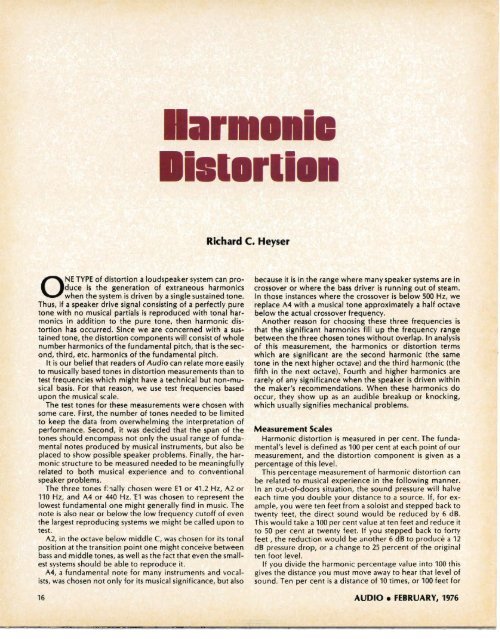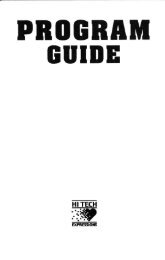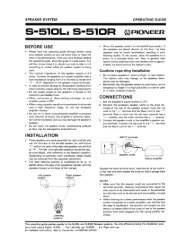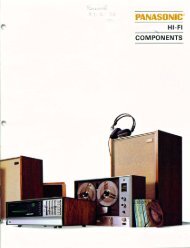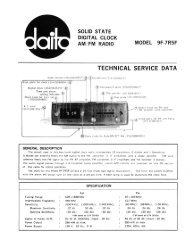The sound - MuleSlow Services
The sound - MuleSlow Services
The sound - MuleSlow Services
You also want an ePaper? Increase the reach of your titles
YUMPU automatically turns print PDFs into web optimized ePapers that Google loves.
I.r • i.<br />
is .rli.<br />
Richard C. Heyser<br />
ONE TYPE of distortion a loudspeaker system can produce<br />
is the generation of extraneous harmonics<br />
when the system is driven by a single sustained tone.<br />
Thus, if a speaker drive signal consisting of a perfectly pure<br />
tone with no musical partials is reproduted with tonal harmonics<br />
in addition to the pure tone, then harmonic distortion<br />
has occurred. Since we are concerned with a sustained<br />
tone, the distortion components will consist of whole<br />
number harmonics of the fundamental pitch, that is the second,<br />
third, etc. harmonics of the fundamental pitch.<br />
It is our belief that readers of Audio can relate more easily<br />
to musically based tones in distortion measurements than to<br />
test frequencies which might have a technical but non-musical<br />
basis. For that reason, we use test frequencies based<br />
upon the musical scale.<br />
<strong>The</strong> test tones for these measurements were chosen with<br />
some care. First, the number of tones needed to be limited<br />
to keep the data from overwhelming the interpretation of<br />
performance. Second, it was decided that the span of the<br />
tones should encompass not only the usual range of fundamental<br />
notes produced by musical instruments, but also be<br />
placed to show possible speaker problems. Finally, the harmonic<br />
structure to be measured needed to be meaningfully<br />
related to both musical experience and to conventional<br />
speaker problems.<br />
<strong>The</strong> three tones f:,ally chosen were E1 or 41 .2 Hz, A2 or<br />
110 Hz, and A4 or 440 Hz. E1 was chosen to represent the<br />
lowest fundamental one might generally find in music. <strong>The</strong><br />
note is also near or below the low frequency cutoff of even<br />
the largest reproducing systems we might be called upon to<br />
test.<br />
A2, in the octave below middle C, was chosen for its tonal<br />
position at the transition point one might conceive between<br />
bass and middle tones, as well as the fact that even the smallest<br />
systems should be able to reproduce it.<br />
A4, a fundamental note for many instruments and vocalists,<br />
was chosen not only for its musical significance, but also<br />
16<br />
because it is in the range where many speaker systems are in<br />
crossover or where the bass driver is running out of steam.<br />
In those instances where the crossover is below 500 Hz, we<br />
-replace A4 with a musical tone approximately a half octave<br />
below the actual crossover frequency.<br />
Another reason for choosing these three frequencies is<br />
that the significant harmonics fill up the frequency range<br />
between the three chosen tones without overlap. In analysis<br />
of this measurement, the harmonics or distortion terms<br />
which are significant are the second harmonic (the same<br />
tone in the next higher octave) and the third harmonic (the<br />
fifth in the next octave). Fourth and higher harmonics are<br />
rarely of any significance when the speaker is driven within<br />
the maker's recommendations. When these harmonics do<br />
occur, they show up as an audible breakup or knocking,<br />
which usually signifies mechanical problems.<br />
Measurement Scales<br />
Harmonic distortion is measured in per cent. <strong>The</strong> fundamental's<br />
level is defined as 100 per cent at each point of our<br />
measurement, and the distortion component is given as a<br />
percentage of this level.<br />
This percentage measurement of harmonic distortion can<br />
be related to musical experience in the following manner.<br />
In an out-of-doors situation, the <strong>sound</strong> pressure will halve<br />
each time you double your distance to a source. If, for example,<br />
you were ten feet from a soloist and stepped back to<br />
twenty teet, the direct <strong>sound</strong> would be reduced by 6 dB.<br />
This would take a 100 per cent value at ten feet and reduce it<br />
to 50 per cent at twenty feet. If you stepped back to forty<br />
feet, the reduction would be another 6 dB to produce a 12<br />
dB pressure drop, or a change to 25 percent of the original<br />
ten foot level.<br />
If you divide the harmonic percentage value into 100 this<br />
gives the distance you must move away to hear that level of<br />
<strong>sound</strong>. Ten per cent is a distance of 10 times, or 100 feet for<br />
AUDIO. FEBRUARY, 1976


